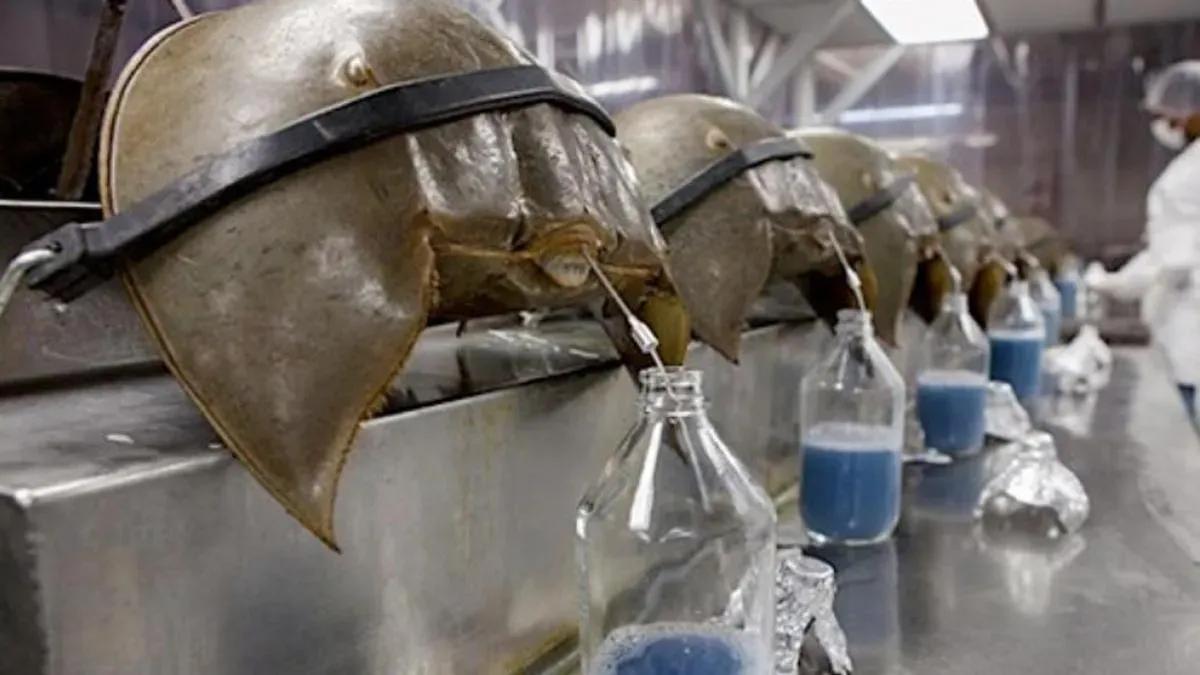Blood Collection from Horseshoe Crabs
Who hasn't dreamed of a prince or princess with blue blood, a myth originating from the Middle Ages, where the royalty's paler skin made their veins appear blue, even though, as we all know, blood is red, regardless of whether it's from royalty or not. [1] In reality, there are indeed some animals that have blue blood. This is because, instead of blood as we know it, they have a similar substance called hemolymph, whose blue color is due to the presence of copper in hemocyanin, just as hemoglobin contains iron. Both are molecules responsible for transporting oxygen. Various invertebrate animals have this “blood,” but none are as significant as the horseshoe crabs or Limulus polyphemus.
Despite their name, these living fossils are not crabs or crustaceans; they are marine invertebrates that have barely changed over millions of years. They belong to the class Merostomata, an ancient group currently consisting of only four species, three of which are Asian and one American. These animals move in shallow waters along coasts and can be found from Maine to the Yucatan Peninsula. Horseshoe crabs have been of interest for a long time and have been used in agriculture and fishing industries, serving as fertilizers, feed, bait, and more, but their most fascinating role is in biomedicine and public health. Their role in vaccines, injectable drugs, and medical devices is mainly attributed to quality control, ensuring these products are free from bacterial endotoxins, where hemolymph comes into play. Due to their lifestyle, they are constantly exposed to numerous bacteria and threats, having developed a defense mechanism known as Limulus Amebocyte Lysate or LAL. [2]

This mechanism causes coagulation around any endotoxin-containing bacteria entering the crab's circulatory system. The LAL test is used to analyze if products are contaminated by observing coagulation, an extremely efficient method that can detect concentrations at very low levels and is used worldwide. The problem with this highly effective and vital test for the pharmaceutical industry is that it requires hemolymph from around half a million crabs annually, from which approximately 100 ml is extracted, resulting in about 15% of the crabs not surviving this process. [2]
Various methods can execute the test itself, but generally, the Limulus Amebocyte Lysate method is used to measure interactions between endotoxins and the factor C proenzyme, sequestered from the crab’s amebocytes. This proenzyme’s proteolytic activity is activated in the presence of lipopolysaccharides. The levels of endotoxins are determined by measuring the activity of factor C in the presence of a colorless chromogenic peptide substrate that releases p-nitroaniline (pNA) after proteolysis, producing a yellow color measured at 405 nm. The color intensity is directly proportional to the amount of endotoxin present. This method can identify endotoxins in various samples, including proteins, peptides, nucleic acids (both DNA and RNA), and antibodies. It is now the industry-standard assay for endotoxin detection. It can detect endotoxins in a range from 0.01 to 1 EU/ml (endotoxin units per ml), and due to its high specificity, ß-glucans do not interfere, making it useful for a wide range of samples mentioned earlier, with results obtainable in just 20 minutes. [3]
Thus, our blue-blooded prince plays a crucial role in the development of most pharmaceuticals and many other industrial products. However, this practice is not sustainable, as the large number of animals required poses a significant risk to their survival, especially since outside of America, the animals are not returned to the wild and bleed to death. Even those returned to nature often become lethargic and disoriented, posing a risk since their collection occurs during spawning season when they come ashore. Upon returning to the sea, they may not find their way back to spawn. [4] This is where biotechnology plays two important roles: one is utilizing a natural resource like hemolymph, and the other is filling the vast opportunity gap presented, as in vivo collection is risky and unsustainable, making recombinant production seem like the future-forward option. This recombinant factor C is already a reality but involves several challenges. One model for recombinant hemolymph production is the silkworm, Bombyx mori, but as reviewed by Minkner et al. in 2020, purifying these recombinant proteins is very challenging due to the model's inherent proteins, necessitating greater manipulation, higher costs, and a difficult-to-scale process to meet industry demands. [5]

At the end of the day, nature offers us a multitude of beneficial tools applicable in various industries. Despite their efficiency, their overexploitation will never be viable. Biotechnology provides the opportunity to address problems from multiple angles, some of which, like simple blood extraction, are easy and efficient but unsustainable. In contrast, recombinant production is not easy and involves a loss of efficiency, but it is the only realistic option for the long term.
References
1. Por qué se dice que los reyes tienen la sangre azul. (2023). El Mundo. https://www.elmundo.es/como/2023/07/17/64b520aae4d4d839608b456f.html
2. Martínez, C. (2017). El cangrejo herradura tiene la sangre azul. Museo Nacional de Ciencias Naturales. https://www.mncn.csic.es/es/comunicacion/blog/el-cangrejo-herradura-tiene-la-sangre-azul
3. Endotoxin Quantitation, Removal, and Detection, (2024). Thermo Fisher. https://www.thermofisher.com/mx/es/home/life-science/protein-biology/protein-purification-isolation/protein-purification/endotoxin-quantitation-removal.html
4. Maron, D. F. (2022, August 5). El cangrejo herradura salva vidas gracias a su sangre única pero, ¿podemos proteger a estos animales? National Geographic. https://www.nationalgeographic.es/animales/2022/08/el-cangrejo-herradura-salva-vidas-gracias-a-su-sangre-unica-pero-podemos-proteger-a-estos-animales
5. Minkner, R., Xu, J., Zagst, H., Wätzig, H., Kato, T., Oltmann-Norden, I., & Park, E. Y. (2020). A systematic and methodical approach for the efficient purification of recombinant protein from silkworm larval hemolymph. Journal of Chromatography. B, Analytical Technologies in the Biomedical and Life Sciences, 1138(121964), 121964. https://doi.org/10.1016/j.jchromb.2019.121964


Comments